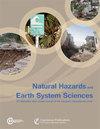The influence of aftershocks on seismic hazard analysis: a case study from Xichang and the surrounding areas
IF 4.2
2区 地球科学
Q1 GEOSCIENCES, MULTIDISCIPLINARY
引用次数: 0
Abstract
Abstract. In some instances, a strong aftershock can cause more damage than the mainshock. Ignoring the influence of aftershocks may lead to the underestimation of the seismic hazard of some areas. Taking Xichang and its surrounding areas as an example and based on the Seismic ground motion parameters zonation map of China (GB 18306-2015), this study used the Monte Carlo method to simulate synthetic mainshock sequences. Additionally, the Omi–Reasenberg–Jones (Omi–R–J) aftershock activity model is used to simulate the aftershock sequences that follow mainshocks above a certain magnitude threshold. Then, the mainshock and the aftershocks are combined to calculate the regional seismic hazard using ground motion prediction equations (GMPEs). Finally, the influence of aftershocks on seismic hazard analysis is examined and considered. The results show that in areas with moderate to strong seismic backgrounds, the influence of aftershocks on probabilistic seismic hazard analysis can exceed 50 %. These results suggest that the impact of aftershocks should be properly considered for future probabilistic seismic hazard analyses, especially in areas with moderate to strong seismic activity backgrounds and in areas prone to secondary disasters such as landslides and mudslides.余震对地震灾害分析的影响:西昌及周边地区的案例研究
摘要在某些情况下,强烈余震可能比主震造成更大的破坏。忽视余震的影响可能会导致低估某些地区的地震危险性。本研究以西昌及其周边地区为例,根据《中国地震地面运动参数区划图》(GB 18306-2015),采用蒙特卡洛法模拟合成主震序列。此外,还使用 Omi-Reasenberg-Jones(Omi-R-J)余震活动模型模拟超过一定震级阈值的主震之后的余震序列。然后,将主震和余震结合起来,利用地动预测方程(GMPEs)计算区域地震灾害。最后,研究并考虑余震对地震灾害分析的影响。结果表明,在中强地震背景地区,余震对地震危险性概率分析的影响可超过 50%。这些结果表明,在未来的地震危险性概率分析中,应适当考虑余震的影响,尤其是在具有中强地震活动背景的地区以及易发生滑坡和泥石流等次生灾害的地区。
本文章由计算机程序翻译,如有差异,请以英文原文为准。
求助全文
约1分钟内获得全文
求助全文
来源期刊
CiteScore
7.60
自引率
6.50%
发文量
192
审稿时长
3.8 months
期刊介绍:
Natural Hazards and Earth System Sciences (NHESS) is an interdisciplinary and international journal dedicated to the public discussion and open-access publication of high-quality studies and original research on natural hazards and their consequences. Embracing a holistic Earth system science approach, NHESS serves a wide and diverse community of research scientists, practitioners, and decision makers concerned with detection of natural hazards, monitoring and modelling, vulnerability and risk assessment, and the design and implementation of mitigation and adaptation strategies, including economical, societal, and educational aspects.

 求助内容:
求助内容: 应助结果提醒方式:
应助结果提醒方式:


